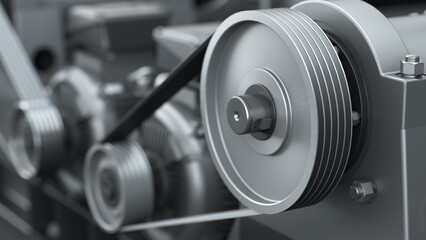Introduction
Cooling tower belt drives are essential for transferring power from the motor to the cooling tower fan, ensuring proper airflow and optimal cooling performance. There are different types of belt drives used in cooling towers, each with its own advantages and specific applications. Regular maintenance of belt drives is crucial to prevent breakdowns, improve efficiency, and extend the lifespan of the cooling tower.
Types of Cooling Tower Belt Drives
V-Belt Drives
V-belt drives are the most common type used in cooling towers. They have a trapezoidal cross-section and operate with pulleys. V-belts provide reliable performance and are capable of handling moderate to high loads, making them ideal for most cooling tower applications. They are cost-effective and relatively easy to maintain.
Timing Belt Drives
Timing belts, also known as synchronous belts, are designed with teeth that fit into the pulleys, preventing slippage. These are used when precise timing and synchronization between the motor and the fan are necessary. Timing belts provide higher efficiency compared to V-belts but may require more precise installation and maintenance.
Flat Belt Drives
Flat belts are less common in cooling towers but are still used in some applications where low noise and high-speed transmission are required. These belts operate on flat pulleys and have low friction losses, making them more energy-efficient but less capable of handling heavy loads compared to V-belts.
Multi-Groove or Poly-V Belt Drives
Poly-V belts combine the advantages of flat belts and V-belts. They offer higher efficiency, compact design, and greater power transmission capacity. These belts are often used in larger cooling towers or systems that require higher performance and reliability.
Maintenance Tips for Cooling Tower Belt Drives
Regular Inspection
Inspect the belt drives regularly for signs of wear, cracking, or fraying. Early detection of wear can prevent belt failure and costly downtime. Also, check for proper alignment between the pulleys and tension in the belts.
Tension Adjustment
Ensuring the correct tension in the belts is critical for efficient operation. Too much tension can lead to bearing wear, while insufficient tension can cause slippage and reduced power transmission. Adjust tension periodically using a belt tension gauge to maintain optimal performance.
Lubrication of Components
While belts themselves do not require lubrication, the bearings and shafts within the belt drive system need proper lubrication to prevent friction and wear. Use the recommended lubricants for the specific cooling tower system to ensure smooth operation.
Belt Replacement
Over time, belts will naturally wear out and require replacement. Always use high-quality belts and replace them according to the manufacturer’s guidelines. Using worn-out belts can result in inefficiencies, increased energy consumption, and damage to other components.
Alignment Check
Misalignment between pulleys is a common cause of belt wear and failure. Ensure that the pulleys are aligned properly to avoid uneven wear on the belts and excessive vibration. Use a laser alignment tool for precise alignment during installation or maintenance checks.
Monitor Belt Tensioning
Over time, belts can stretch and lose tension. Regularly monitor and adjust the tension to avoid slippage or overloading the motor. Automatic tensioning devices can also be used to ensure consistent tension throughout the belt’s lifespan.
Clean the Belts and Pulleys
Dust, debris, or oil accumulation on the belts and pulleys can cause slipping and reduce efficiency. Keep the belts and pulleys clean by wiping them down during regular maintenance. This helps in preventing contamination-related failures.
Monitor Noise and Vibrations
Unusual noises or excessive vibrations are often early signs of belt or pulley issues. Investigate these signs immediately to prevent further damage to the system. Excessive vibrations may indicate belt wear, misalignment, or tension issues.
Conclusion
Cooling tower belt drives are crucial to maintaining proper airflow and overall cooling tower efficiency. Understanding the different types of belt drives and adhering to regular maintenance practices will ensure longer operational life and reduce the likelihood of unexpected failures. By paying attention to factors like tension, alignment, and wear, facility managers can keep their cooling towers running smoothly and efficiently.

